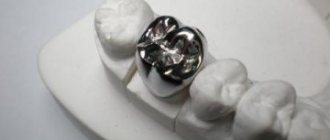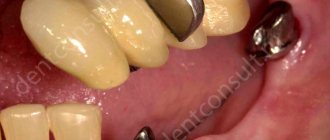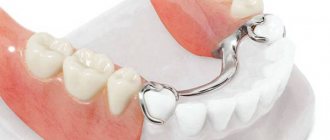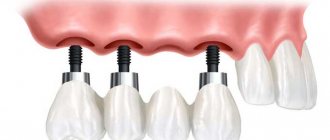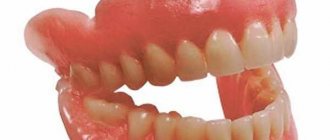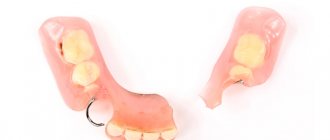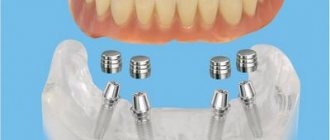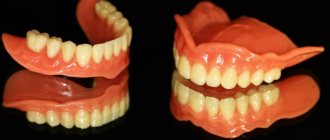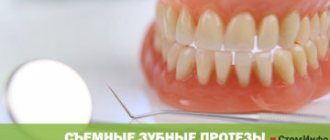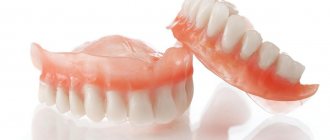August 23, 2019
The trend is that today an increasing number of patients, after losing one or more teeth, resort to high-quality implantation methods. However, some still prefer prosthetics with bridge structures, which are cheaper. But did you know that bridges are also different? Have you heard anything about the most mysterious of them - adhesive bridges in dentistry? If not, read the article by the editors of the UltraSmile.ru portal. You will find a lot of useful information on this topic.
Fact #1: There is no need to grind your teeth for adhesive bridges.
An adhesive bridge, just like a classic one, is most often placed when one tooth is missing. It rests on neighboring units located on either side of the lost one. However, compared to the classic design, which consists of three crowns, the adhesive apparatus looks different: it has only one crown and plates extending from it, which look like “wings”. In this case, these same plates will be attached to the supporting teeth. But to install them, there is no need at all to grind and prepare the supports, change their appearance beyond recognition and remove the nerve - as this has to be done before installing classic bridges. It will be enough to make small ledges on the supporting units (on their lateral or palatal surface - from the side of the tongue) and use dental glue.
When installing such dentures, adjacent teeth are not ground down
Adhesive structures, like any other dentures, cannot be installed during bruxism, inflammation of periodontal tissues and the presence of severely loose or destroyed supporting teeth.
The absence of the need to prepare hard tissues and depulpate the tooth is a plus, because The installation procedure for such structures does not require invasive intervention and is painless. In addition, thanks to this approach, the supporting teeth take on minimal load and do not wear out as much as compared to those under classic traditional bridges consisting of three artificial crowns. Another advantage: their processing process is reversible; when the adhesive structure is removed, holes and ledges in the supports can be easily masked with composite material.
Prices
The cost of a structure is influenced by many factors. First of all, it all depends on the choice of dental clinic. The qualifications of the doctor and the level of the center increase or decrease the price of an artificial prosthesis . The difference is about 15-20%.
The material from which the bridge is made also matters:
- Plastic is the cheapest, costing about 1,000 rubles;
- Alloy of chromium and cobalt 3,000 – 4,000 rubles;
- metal ceramics will cost 5,000 – 6,000 rubles.
Since the structure can be installed on several supports, the price also increases with their addition. If a single piece of ceramics costs 15,000 rubles, then a system for three units costs 44,000 rubles.
Fact #2: There are different types of adhesive bridges.
An adhesive bridge in the absence of one tooth helps to hide the defect and restore the integrity of the dentition. However, depending on the clinical situation, the patient’s expectations and his financial capabilities, dentists can offer different designs of adhesive bridges.
Classic design with fiberglass stripes
This is the most popular model today. It looks aesthetically pleasing, is inexpensive, and can be done in one visit to the dentist.
The bridge consists of a crown, from which wing plates extend in each direction, made of a durable and very aesthetic white material, namely fiberglass. The crown itself is created (increased) from a composite. To install the structure, the doctor lightly sands the support units from the inside and attaches the plates using adhesive. Next, a composite tooth is built up on the plate.
The photo shows classic adhesive bridges
An adhesive bridge is very similar in appearance to a removable immediate butterfly prosthesis, but unlike it, it is non-removable, and therefore more comfortable and aesthetically pleasing for the patient. And it has “wings” only on one side.
Beam model
Here the “wings” of the product are made of a thin metal plate. First, the doctor fixes such a plate in the ledges of the supporting teeth, and then builds an artificial crown made of composite on it. The construction costs a little less than the one made of fiberglass. This type of prosthetics is the most inexpensive. However, we must remember that it should be considered with caution by allergy sufferers, because. the metal component can be rejected by the body, cause irritation of the mucous membrane, promote galvanic syndrome and oxidize, distorting the taste of food.
With the beam model, the wings are metal
“I recently visited a dentist and he suggested I install an adhesive bridge. In the absence of 1 tooth (first injury, and then removal), I did not want to undergo prosthetics before, because... I would have to grind down other teeth for a regular bridge, and I had no idea or heard anything about the existence of adhesive ones. To be honest, I was interested in the offer, and the price suited me - I paid 12 thousand rubles. The big advantage is that there is no need to depulp the supports and kill them, which is very pleasing.”
Arkady F, review from 32top.ru
Tabbed design
For patients who want to get the most aesthetic and durable restoration, and are also willing to spend more money on treatment than in the first two cases, doctors offer adhesive bridges made of ceramic or zirconium dioxide, or plastic. They consist entirely of the selected material, i.e. and the crown and wings extending from it. Such structures are more reliable and stable than those made from composites; they are not subject to rapid loosening, because are installed inside the supporting teeth, just like inlays. However, it will not be possible to install such dentures in one visit to the dentist, because... they must first be made in a dental laboratory.
This is what dentures with inlays look like
Dentures with locks
The most perfect, aesthetic and high-quality, but at the same time the most expensive, and therefore not so common option in medical practice - bridges with locks. Such structures are classified as conditionally removable, because if necessary, the doctor can remove them without damaging the fastenings and return them back to their place.
The advantages of adhesive bridges: gentle treatment of the hard tissues of the supporting units, restoration of smile aesthetics in one visit, the ability to install the structure without the use of anesthesia1.
The photo shows designs with locks
The design consists of a crown in which one part of the fastening is located. The doctor performs the second part of the fastening in the supporting teeth: for this, he makes a small cavity in the hard tissues, which is then covered with a composite. The two parts of the micro-locks snap tightly together, and the restoration is completely invisible to others.
I have an opinion
Adhesive dental prosthetics is gaining increasing popularity, as confirmed by numerous patient reviews.
After I learned about Rochetta retainers, I immediately decided to install them. It’s good that I turned to a private dental clinic, which has many positive reviews and has not undermined its reputation.
There I was given a thorough examination, the procedure for making and installing the prosthesis was performed by doctors with extensive experience, so I completely trusted them. Besides that, I didn’t even have my teeth trimmed. After the procedure, I saw that all the teeth were in place, but I did not notice any differences between the artificial and real teeth.
Alexandra, 48 years old
I decided to use adhesive bridges because they are low cost, and after installation the results are no worse than with expensive implants. Of course, this process is quite lengthy, but it is worth it.
Now I can eat food, talk, smile normally, and all thanks to these bridges!
Nadezhda, 42
Photo selection of patients before and after they had an adhesive bridge installed:
Fact #3: Adhesive restorations are only suitable for front teeth
Experienced doctors advise installing them only on the anterior units, but they are not suitable for masking defects in the chewing teeth due to their fragility and unreliable fastening, because they will not be able to bear a significant load. It is for this reason that they cannot restore more than 1 tooth, while classic bridges can restore up to 4 missing teeth in a row.
The good thing about the structures is that they can be installed using the direct method, in just one visit to the dentist. But if you expect to perform higher-quality prosthetics, then it is still better to choose those varieties that are created by an indirect laboratory method from ceramics or zirconium dioxide - however, in this case, you will have to visit the doctor at least several times.
These designs are only suitable for front teeth.
We can say that adhesive bridges are structures whose main purpose is to restore the aesthetics of a smile and visually disguise the defect. They will also be able to prevent the displacement of neighboring units to the place of the lost tooth, but they will not help with restoring the full functionality of the dentition. They will have to follow dietary restrictions: no tough or solid foods. Therefore, it is recommended to use this type of device only as a temporary measure, for example, immediately after tooth extraction, when you need to hide this fact from others, or, for example, before implantation.
Fact #4: Wearing bridges can cause tooth decay.
When installing a bridge, the dentist glues its wings to the surface and ledges made in the supporting teeth. The design itself seems simple, but caring for teeth in the area where the plates are located is not so easy. If the plates are not glued very well, then pieces of food and bacteria can get clogged under them, which will provoke inflammation and cause the development of caries.
“I wore such a bridge, I can say that at first it really seems quite beautiful, and its price is even more pleasing, and plus there is no need to depulpate the teeth. BUT, after 1-2 years the beauty of the smile deteriorates sharply, it seems that the bridge is not adjacent to the gum, but is simply dangling in the air, i.e. a distance appears between it and the gum. And this is inevitable, the doctor told me that it is bone atrophy that leads to this effect. Only an implant will save you from atrophy. And girls, in the end I spent 8 thousand on the bridge, and then 30 thousand on the implant. Now I understand that these bridges do not even delay the costs of treatment, but only increase them even more!”
Margot, review from otzovik.com
A patient who wears an adhesive device needs to improve oral hygiene and purchase an irrigator in order to efficiently remove the smallest food debris and plaque. You also need to visit the dentist twice a year to assess the condition of the supporting units and to check the quality of the bridge fastening. As practice shows, in some patients this type of construction partially or completely comes off during use, which causes some discomfort and forces you to constantly be on edge.
Notice
: Undefined variable: post_id in
/home/c/ch75405/public_html/wp-content/themes/UltraSmile/single-item.php
on line
45 Notice
: Undefined variable: full in
/home/c/ch75405/public_html/wp-content /themes/UltraSmile/single-item.php
on line
46
Rate this article:
( 1 ratings, average: 5.00 out of 5)
prosthetics
- Lutskaya I.K. Prospects for adhesive prosthetics in therapeutic dentistry. Modern dentistry, 2011.
Expert “Adhesive structures have a right to exist. They really help out those patients who are not yet ready to financially invest in a longer-term prosthetic option, but still want to restore the aesthetics of their smile. However, if you are choosing between types of adhesive bridges, then choose those that are made of higher quality materials: ceramics, zirconium dioxide. Products made from composites quickly lose their aesthetics; difficult-to-remove bacterial deposits, odors, and dyes accumulate on them; they do not recreate the shine of natural enamel and require constant polishing. However, here again you need to evaluate how long the prosthesis is installed.” Therapist, surgeon, orthopedist Vladislav Olegovich Vataev
Consulting specialist
Vagapov Zakir Irkinovich
Doctor rating: 7 out of 10 (3) Specialization: Orthodontist Experience: 14 years
Care
To increase the service life of the prosthesis, it is necessary to follow the rules of care for it and the oral cavity. They are simple and become a habit over time:
- Regular cleaning of teeth and dentures with good toothpaste. It is advisable to carry out after each meal, the goal is to prevent the accumulation of food debris in the prosthesis area. If this is not possible, rinse your mouth.
- regular professional hygiene. Minimum – once every six months, ideally – every 3 months.
- timely treatment of abutment teeth. You need to examine them yourself and if you find caries or problems with the gums, contact your dentist.
- refusal of hard foods. In order to extend the service life of the bridge, it will be necessary to minimize any processes that contribute to its failure.
It is not advisable to use floss in the denture area.
By following these rules, the patient keeps the prosthesis in working condition and delays the replacement period.
Comments
I’m 50 years old, the doctor recommended that I have my front tooth removed - it put me at a dead end, I wasn’t ready, and I don’t have much money right now. I was very worried that I would have to install a regular bridge. Now, thanks to your article, I know that there is an inexpensive alternative - an adhesive bridge. But my question is, how long will it last me?
Taranova G.L. (09/06/2019 at 09:03) Reply to comment
- It makes sense to consider an adhesive bridge as a very short-lived or temporary solution. Its actual service life is 1-3 years. Due to its fragility, such a structure often breaks in the fixation zone, cracks appear on it - this happens because most patients during operation forget that the bridge should not be subjected to a strong chewing load and try to chew solid food. But as an inexpensive temporary solution after a front tooth extraction, it is a good option. The main thing is to decide during its operation what to do next, consider other, more durable options for prosthetics or implantation.
Editorial staff of the portal UltraSmile.ru (08/09/2019 at 08:55) Reply to comment
